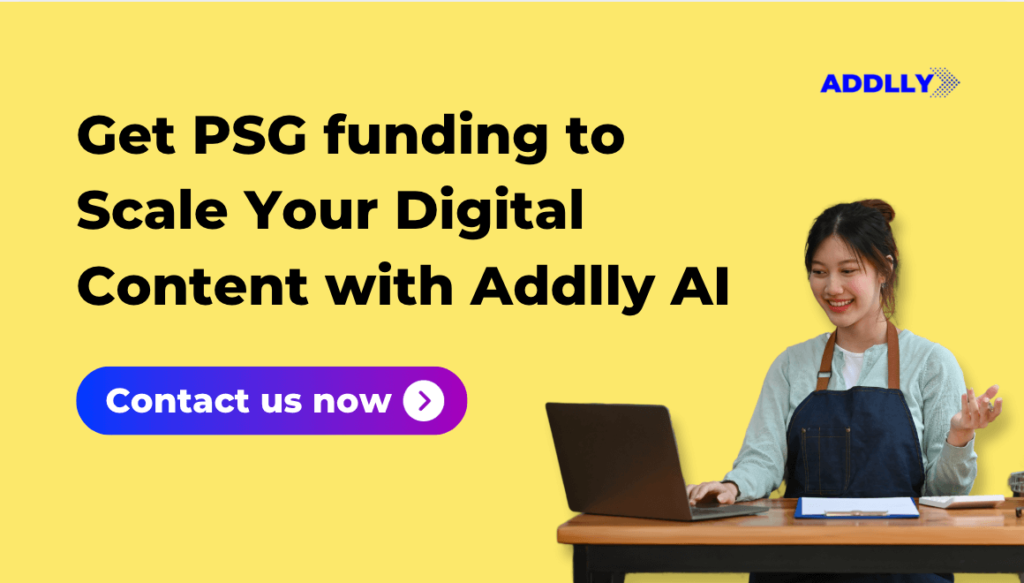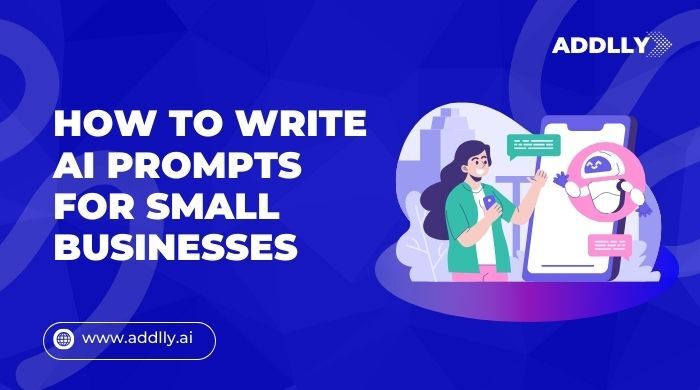Believe it or not, using the right words can make all the difference when it comes to writing AI prompts for small businesses. Good prompt writing helps LLMs (Large Language Models) understand exactly what you need, making your AI generated content more relevant, useful, and creative. Whether you’re using generative AI for content creation, research, or automation, knowing how to write effective prompts ensures you get the best possible output.
Understanding how to craft effective AI prompts helps businesses maximize their marketing efforts and create a strong value proposition. As small business owners, you may be looking for ways to use AI to scale your business up, come up with a marketing strategy, conduct market research, find relevant keywords, or just smooth out the workflows in your company.
In this guide, we will explore the best ways to write AI prompts for businesses in 2025. We will cover essential strategies, common mistakes to avoid, and how AI platforms like Addlly AI can enhance marketing campaigns and business growth.
What Are AI Prompts?
AI prompts are instructions given to AI tools to generate relevant data, marketing materials, and business strategies. These prompts help small business owners automate content creation, improve social media strategies, generate social media posts, and enhance customer relationships. The quality of AI generated content depends on how well the prompts are written.
Using effective AI prompts allows businesses to improve their content marketing tactics, refine their brand identity, streamline their business operations, and gain a competitive advantage. By aligning prompts with their business niche, companies can ensure that AI generated content meets their key performance indicators and marketing goals.

Importance of Crafting Effective Prompts for Small Business Owners
As many as 1,467 CEOs of small and mid-sized businesses (SMBs) think that AI has had the maximum impact on their business out of all technologies that emerged in the past decade.
The impacts may not always be business oriented like increases in revenue or leads generated. But more so the operation impact of offloading simple tasks like writing emails, daily reports, and fixing broken spreadsheet formulas. These simple tasks add up to a lot of time spent, which you can otherwise use to do more important things.
But once you get the hang of incorporating AI into your daily routines as small business owners, you can:
- Offload repetitive work to free up your time for more strategic tasks that boost your business growth.
- Minimise time-consuming efforts such as coming up with social media strategies, social media posts, proposing unique value propositions through enticing copies, and more.
- Reduce inaccuracies and mistakes in important items that may affect customer relationships, like typos in emails or attaching the wrong brochure or promotional campaign.
- Build your second brain to help suggest strategies to generate leads, be in touch with the industry trends, run a market analysis, and do other tasks that may require your brain to work harder.
But once you’ve gotten into a larger company scale, our article on generative AI for enterprise has all the necessary tips for you.
Best Practices for Writing AI Prompts for Small Businesses
Here are the must-know pointers to write effective AI prompts:
1. Be Specific and Clear
AI performs best with well-defined instructions that provide specific parameters of what you want it to generate or do for you. Here’s a quick comparison between a generic and well-defined prompt:
- Generic prompt: Write a post about small businesses
- Good prompt: Create a short, engaging Instagram caption on how AI helps small businesses save time.
If optimizing for SEO, you should also find relevant keywords to ensure the AI model generates content that is aligned with search intent and target market. Better yet, use our 1 click blog post writer for a hassle-free and SEO-optimised articles or AI newsletter generator depending on what you need.
Additionally, you can also download our guide book on the best practices of generative AI for SEO:
2. Provide Context
Providing the full context like your company’s name, industry, competitors, use cases, and others into the prompt is also an absolute must. This will allow the AI to get a better understanding of what it needs to generate, resulting in more appropriate and ready-to-use outcomes.
For instance, if you want to compile a list of business ideas to try, be specific about the budgets, where you are located, and the current market trends in your locale. That way, the AI model won’t generate something outrageous that isn’t anywhere within your budget or areas of interest.
3. Define the Desired Outcome
Clearly specifying the output you need helps the AI-generated content to follow a specific format, tone, and structure. Without clear limitations and specifications, the AI will have full range of creativity, leading it to decide the best output for you – which may not always be the best.
For example, if you want to use AI to generate a piece of content for you, specify the following:
- Content Format: Specify the output format, such as blog posts, newsletter, social media post, etc.
- Tone & Style: Indicate whether the tone should be professional, conversational, persuasive, or data-driven.
- Key Focus Areas: Identify key information that is of the highest priority, like industry information, customer challenges, or comparative positioning
Providing clear instructions minimizes the number of revisions necessary and helps AI-produced text align with the purpose of your business.
4. Give Examples to Follow
AI can effectively replicate specific styles, tones, or formats when provided with clear examples. If a particular voice or structure is required, include a sample to guide the AI’s output. For instance:
- “Write a social media post similar to this: ‘Big news! Our summer collection has arrived, packed with simmering goodness.’”
- “Generate a professional LinkedIn post that reflects the tone of this example: ‘In today’s fast-changing market, businesses need agile solutions. Here’s how AI can help.’”
For industry-specific content, adding references to the insider lingos and insights helps the AI-generated responses be aligned with business objectives.
Whether developing a data-driven LinkedIn article, crafting an engaging lead-generation email, or outlining a customer retention strategy, providing clear examples enhances both accuracy and consistency.
5. Specify Target Audience
A message tailored to Gen Z consumers will differ from one aimed at B2B decision-makers. Clearly state the intended audience, such as “Write an email for small retail shop owners exploring AI-driven marketing solutions.”
Clarify whether AI should generate content for entrepreneurs seeking business expansion insights, industry leaders analyzing market trends, or sales teams refining outreach strategies.
Mistakes to Avoid When Writing AI Prompts for Small Businesses
Small business owners are almost always busy building strategic partnerships and generally doing things with significant impact on their business. leading to them being a bit behind on things like the drawbacks and limitations of AI models.
Here are some of the most common mistakes that many people make when it comes to AI:
1. Using Ambiguous Language
A vague request like “Write something about sales” lacks direction and can lead to AI-generated content that misses the mark. Instead, a well-structured prompt, such as “Write a LinkedIn post on how real estate agents can close more deals using AI-powered analytics,” provides clarity and purpose.
2. Ignoring AI Limitations
Unfortunately, AI models don’t have the awareness or critical thinking ability to come up with a robust strategy on its own. If you’re crafting AI-generated content for a product launch, a thorough analysis of the competitive landscape can ensure your messaging stands out. Similarly, including a comprehensive analysis of what makes your offering unique can elevate your content beyond generic messaging.
Shift to No-Prompt Platforms
It comes as no surprise that AI itself is evolving by leaps and bounds to work more intuitively with humans, enabling users to get high-quality results. These advancements help streamline workflows, allowing professionals to focus on strategy and creativity rather than technical skills. This means:
- AI tools now understand intent better, requiring less user input.
- Pre-built templates and smart suggestions make AI more accessible to non-technical users.
- Context-aware models generate relevant content without users having to refine prompts manually.
This shift reduces the learning curve, making AI more intuitive and user-friendly for businesses and individuals alike. Platforms like Addlly help bridge this gap by providing AI-powered tools designed to simplify content creation and marketing.
With AI-driven workflows and context-aware models, Addlly ensures that businesses can generate high-quality content with minimal input at scale. This empowers teams to focus on strategic decision-making rather than manual execution, making AI more accessible and effective for SMEs and enterprises alike.
Using Addlly AI for Custom AI Agents
Addlly AI makes content creation effortless by using its AI marketing agent to learn from your brand, past content, and business goals. It adapts to your style, ensuring that all content is perfectly aligned with your voice, without the need for complex prompts or trial and error.
Key Advantages:
- Simplified Content Creation: Forget the struggle of writing perfect prompts. Just tell Addlly AI what you need, and it delivers tailored, high-quality content every time.
- Consistent, On-Brand Tone: Addlly AI learns your brand’s unique style, ensuring your content feels natural and consistent across all channels.
- Effortless Integration: Whether it’s for marketing, customer support, or internal workflows, Addlly AI integrates seamlessly to handle a wide range of tasks.
- Saves Time: Skip the time spent on refining prompts. Addlly AI does the heavy lifting, allowing you to focus on growing your business.
Addlly’s suite of AI marketing tools have helped SMEs and enterprises grow. Learn how Kino increased its user acquisition by 50% with the help of Addlly!
How SMEs Can Benefit from PSG Grant With DBS x Addlly AI Collaboration
If you’re a small business in Singapore, there’s no better way to keep expenses down than winning a PSG grant. With Addlly’s AI tools, supported by DBS, SMEs can create high-quality content effortlessly, free up time for bigger priorities. This partnership reflects DBS’ vision of digitization and connectivity, ensuring that AI-powered solutions are accessible, easy to use, and built for real business needs.
Whether you’re just starting to explore AI or looking for ways to streamline your workflow, the right tools can make all the difference. The future of content creation is smarter, faster, and more accessible than ever, and we’re here to make it work for you.

Final Words
As AI advances, AI agents are set to replace traditional, complex, prompt-based systems. AI agents have the capability to operate autonomously, learning user preferences and executing tasks proactively.
Imagine an AI marketing assistant that automatically drafts social media posts, schedules content, and adjusts messaging based on audience preferences, all without needing constant input. That’s the future of AI: intelligent, task-driven, and fully integrated into business workflows.

